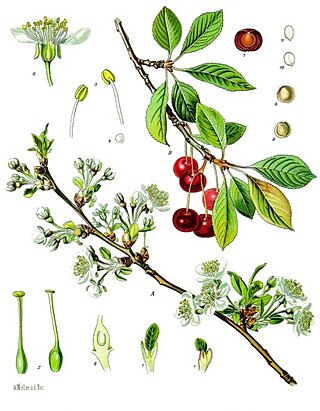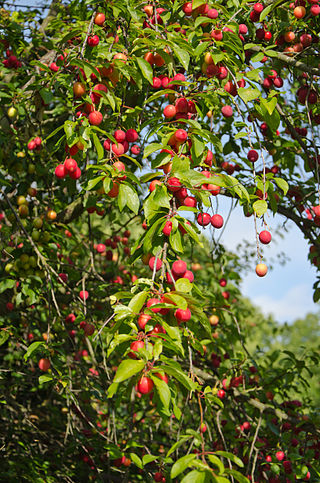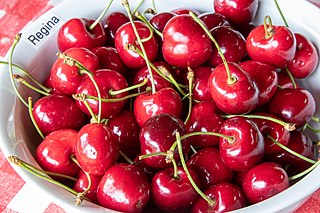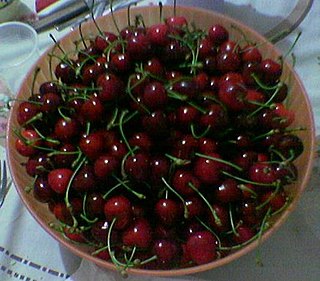
A cherry is the fruit of many plants of the genus Prunus, and is a fleshy drupe.

A plum is a fruit of some species in Prunus subg. Prunus. Dried plums are called prunes.

Prunus is a genus of trees and shrubs, which includes the fruits plums, cherries, peaches, nectarines, apricots, and almonds.

Prunus cerasus is a species of Prunus in the subgenus Cerasus (cherries), native to much of Europe and southwest Asia. It is closely related to the sweet cherry, but has a fruit that is more acidic. Its sour pulp is edible.

A cherry blossom, also known as Japanese cherry or sakura, is a flower of many trees of genus Prunus or Prunus subg. Cerasus. They are common species in East Asia, including China, Korea and especially in Japan. They generally refer to ornamental cherry trees, not to be confused with cherry trees that produce fruit for eating. It is considered the national flower of Japan.

Prunus cerasifera is a species of plum known by the common names cherry plum and myrobalan plum. It is native to Southeast Europe and Western Asia, and is naturalised in the British Isles and scattered locations in North America. Also naturalized in parts of SE Australia where it is considered to be a mildly invasive weed of bushland near urban centers.

Prunus serrulata or Japanese cherry is a species of cherry tree that grows naturally in Japan, China, and Korea, and it also refers to a cultivar produced from Prunus speciosa, a cherry tree endemic in Japan. Historically, the Japanese have developed many cultivars by selective breeding of cherry trees, which are produced by the complicated crossing of several wild species, and they are used for ornamental purposes all over the world. Of these, the cultivars produced by complex interspecific hybrids based on the Oshima cherry are also known as the Cerasus Sato-zakura Group.

Prunus emarginata, the bitter cherry or Oregon cherry, is a species of Prunus native to western North America, from British Columbia south to Baja California, and east as far as western Wyoming and New Mexico. It is often found in recently disturbed areas or open woods on nutrient-rich soil.

Bing is a cultivar of the wild or sweet cherry that originated in the Pacific Northwest, in Milwaukie, Oregon, United States. The Bing remains a major cultivar in Oregon, Washington, California, Wisconsin and British Columbia. It is the most produced variety of sweet cherry in the United States.

Griotte de Kleparow is a dark-red morello, or Griotte, type of cherry which originated from the outskirts of Lviv, modern Ukraine.

Prunus fruticosa, the European dwarf cherry, dwarf cherry, Mongolian cherry or steppe cherry is a deciduous, xerophytic, winter-hardy, cherry-bearing shrub. It is also called ground cherry and European ground cherry, but is not to be confused with plants in the distinct "Groundcherry" genus of Physalis.

The Ulster cherry is a sweet cherry cultivar that originated in the United States.

Prunus avium, commonly called wild cherry, sweet cherry, gean, or bird cherry is a species of cherry, a flowering plant in the rose family, Rosaceae. It is native to Europe, Anatolia, Maghreb, and Western Asia, from the British Isles south to Morocco and Tunisia, north to the Trondheimsfjord region in Norway and east to the Caucasus and northern Iran, with a small isolated population in the western Himalaya. The species is widely cultivated in other regions and has become naturalized in North America and Australia.
Little cherry disease or LChD, sometimes referred to as little cherry, K & S little cherry or sour cherry decline, is a viral infectious disease that affects cherry trees, most notably sweet cherries and sour cherries . Little cherry disease should not be confused with cherry buckskin disease, which is caused by Phytoplasma. Note that both diseases are among the diseases referred to as cherry decline.

Stella is a cultivar of cherry developed in British Columbia, Canada. It is notable as the first self-fertile sweet cherry to be named. It has been awarded the Royal Horticultural Society's Award of Garden Merit.

Lapins is a cultivar of cherry. It is a hybrid of the Van and Stella cultivars. It has been awarded the Royal Horticultural Society's Award of Garden Merit.
Van is a cultivar of cherry originating from Canada.
Prunus × schmittii, Schmitt's cherry, is a nothospecies of flowering cherry that is the result of a cross between Prunus canescens and Prunus avium. It is useful as a street tree in narrow spaces due to its very slender, conical growth form.

Regina is a cultivar of sweet cherry developed in Germany.

Ferrovia is a cultivar of sweet cherry originating in Italy, where it is the most important variety in the Apulia growing region.


















